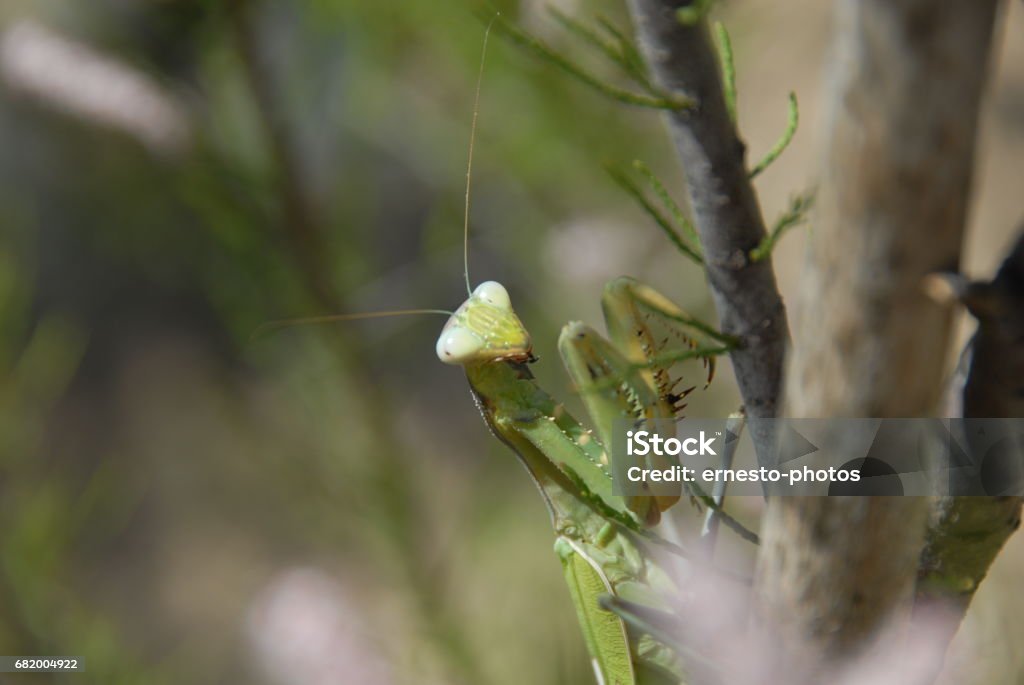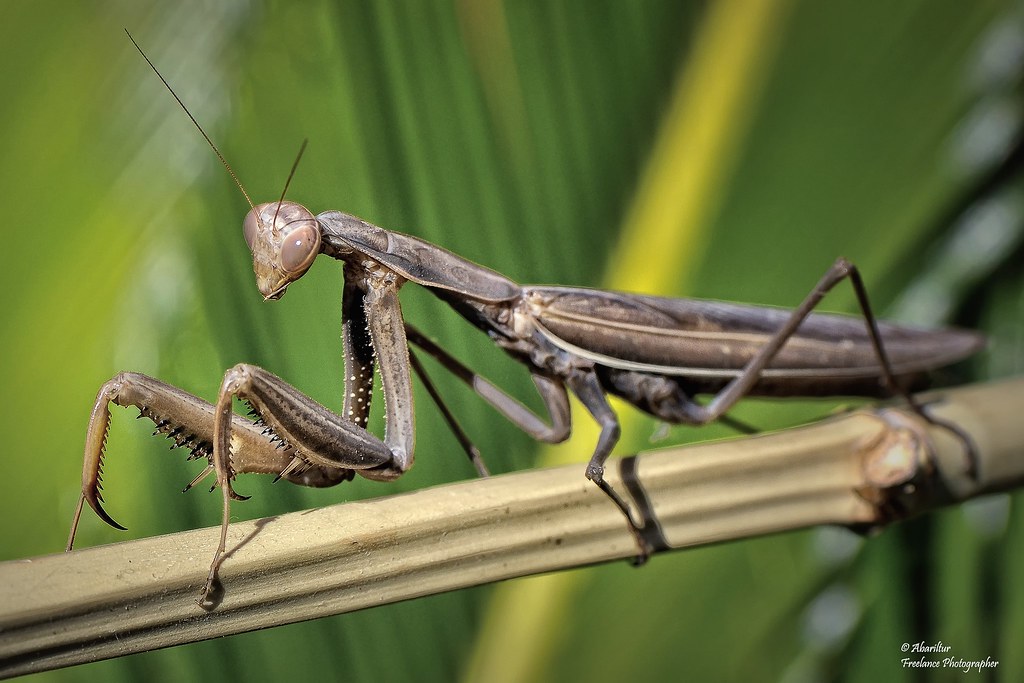Have you ever walked through a Spanish garden, sun dappling through the foliage, and felt a sudden, inexplicable shiver down your spine? Perhaps it was the gentle breeze rustling the leaves, or maybe, just maybe, it was the silent gaze of a creature lurking in the shadows, a creature as captivating as it is deadly. This is the world of the praying mantis, a predator of unparalleled grace and intrigue, and in Spain, its presence is a testament to the vibrant diversity of the Iberian Peninsula’s ecosystem.

Image: www.istockphoto.com
The praying mantis, with its elongated body and forelegs folded in a posture reminiscent of prayer, is a creature that captures the imagination. But beyond its unique appearance lies a fascinating world of hunting strategies, intricate camouflage, and a crucial role in maintaining a delicate balance within the natural world. In Spain, several species of praying mantis thrive, each uniquely adapted to their environment, contributing to the intricate tapestry of life that characterizes this diverse country.
A History of Iberian Mantis: The Evolution of a Predator
The praying mantis, a member of the Mantodea order, boasts an astonishing evolutionary history, stretching back millions of years. While traces of their lineage can be found across the globe, their arrival in Spain is a fascinating tale of adaptation and survival. As the Iberian Peninsula emerged from the ancient ocean, a diverse array of species colonised its newly formed landscapes. Among these newcomers, the praying mantis found a fertile ground, its ability to camouflage and hunt effectively serving it well in the dynamic ecosystem of the Iberian Peninsula.
Through the millennia, different mantis species have thrived in Spain, their evolution shaped by the unique pressures of their environment. From the verdant forests of the north to the sun-baked plains of the south, each species has adapted, its coloration and hunting techniques evolving to perfectly suit its surroundings. This evolutionary journey, marked by the constant struggle for survival, has produced a fascinating array of mantis species, each with its unique story to tell.
Species Spotlight: A Look at the Praying Mantis in Spain
Spain is home to a diverse range of praying mantis species, each adding its unique touch to the country’s insect fauna. Among the most common are:
-
European Mantis (Mantis religiosa): Easily recognized by its green coloration and prominent eyes, the European Mantis is a versatile predator, found in diverse habitats throughout Spain. It’s a particularly adaptable species, adept at changing its tactics to suit its surroundings.
-
Empusa pennata: This species, known for its distinctive, feather-like antennae, is a specialist in capturing moths and other flying insects. Its camouflage, blending perfectly with the vegetation, is a testament to its evolutionary success in the Spanish landscape.
-
Ameles spallanzania: This species, while smaller in stature compared to its larger relatives, is a formidable hunter, utilizing its agility and quick reflexes to subdue prey. Their intricate camouflage, resembling dried leaves or twigs, allows them to blend seamlessly into their surroundings.
Each of these species, a testament to the enduring power of adaptation, plays a vital role in the complex food web of the Iberian Peninsula.
Praying Mantis Habits: Masters of Camouflage, Kings of Patience
The praying mantis, a creature of stealth and precision, is a master of camouflage. Its cryptic coloration, blending perfectly with the surrounding foliage, allows it to remain hidden from both prey and predators, patiently waiting for the perfect moment to strike. Their exceptional camouflage, a product of millions of years of evolutionary adaptation, is a testament to nature’s artistry.
The praying mantis’s “prayer-like” pose, with its forelegs folded in anticipation, is not a mere quirk of nature; it is a hunting tactic honed over eons. These powerful forelegs, equipped with sharp spines, are capable of delivering a lightning-fast strike, disabling prey in a matter of milliseconds. Their keen eyesight, capable of detecting even the slightest movement, allows them to anticipate their prey’s movements with astonishing precision.
While they are formidable predators, the praying mantis is also a delicate creature. Their fragile exoskeletons require meticulous care, and their metamorphosis, a remarkable transformation from nymph to adult, is a testament to the wonders of the natural world. Their sensitivity to the environment highlights the importance of preserving their natural habitats, ensuring the continued survival of these fascinating creatures.

Image: www.flickr.com
The Praying Mantis in Spanish Culture: Symbolism and Folklore
The praying mantis, a creature of myth and legend, has captured the imaginations of cultures across the globe. In Spain, its association with good luck, prosperity, and even divine intervention, is a reflection of its unique presence in the country’s ecosystem and its role in the balance of nature. The sight of a praying mantis, considered a symbol of serenity and peace, inspires a sense of awe and wonder among many Spaniards.
In folklore, the praying mantis is sometimes associated with guardian spirits, protecting travelers and homes from harm. Its presence is seen as a blessing, heralding good fortune and prosperity.
Praying Mantis in Your Garden: A Benefit to Your Ecosystem
Seeing a praying mantis in your garden is a sign of a healthy, thriving ecosystem. As a natural pest control, the praying mantis helps to keep populations of harmful insects in check, promoting biodiversity and contributing to a flourishing garden.
If you encounter a praying mantis in your garden, consider yourself lucky! Encourage its presence by creating a haven for beneficial insects, planting diverse vegetation, and avoiding the use of harmful pesticides. The praying mantis, a silent guardian of your garden, will reward you with the soothing knowledge that your ecosystem is thriving under its watchful gaze.
Praying Mantis Spain
https://youtube.com/watch?v=htgG-_1AAnk
Protect the Praying Mantis: A Call to Action
The praying mantis, a testament to the awe-inspiring diversity of Spain’s ecosystem, is a creature that deserves our respect and protection.
We can contribute to their well-being by:
-
Respecting their habitats: Avoid disrupting natural areas where praying mantises thrive.
-
Choosing organic gardening methods: Minimize the use of pesticides, which can harm praying mantises and other beneficial insects.
-
Educating others: Share your knowledge about these fascinating creatures and encourage others to appreciate their ecological importance.
The praying mantis, a symbol of nature’s artistry and resilience, serves as a reminder of the interconnectedness of life and the importance of preserving our planet’s biodiversity. By taking action to protect these fascinating creatures, we can ensure that they continue to grace our gardens and enrich our lives for generations to come.






